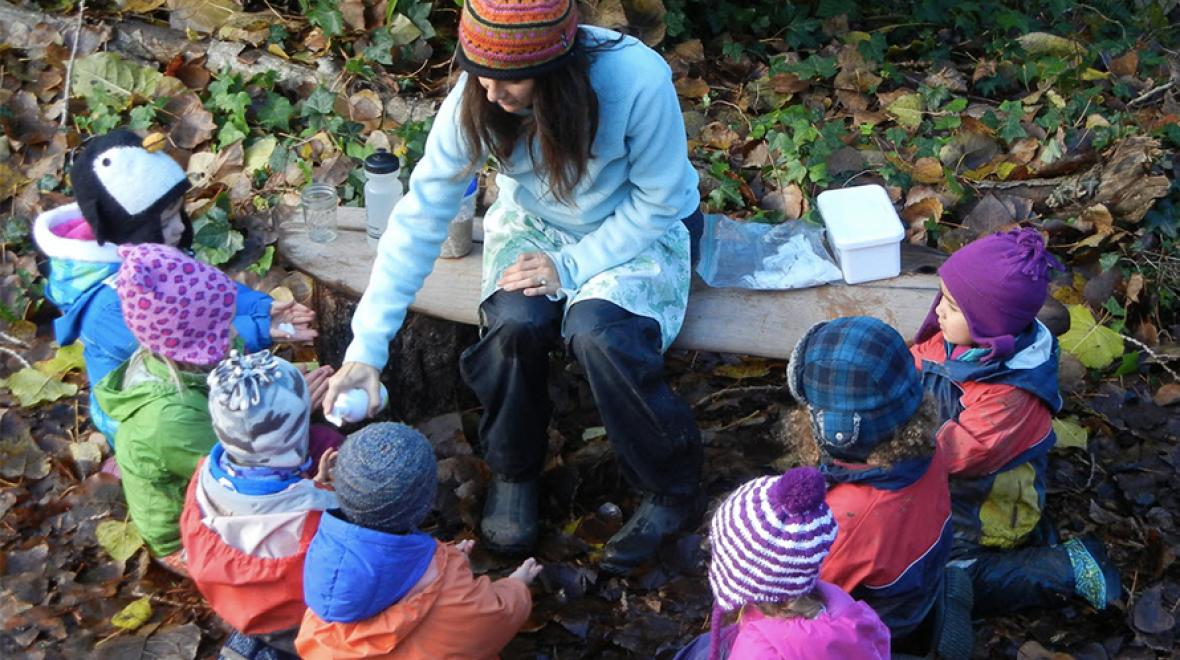
Photo:
Photo courtesy: Seattle Waldorf School
What is an outdoor preschool?
The preschoolers at Fiddleheads Forest School at Seattle's Washington Park Arboretum are outdoors for every minute of their four-hour school day.
This means the children become firsthand witnesses to everything happening in their forest grove classroom: a Cooper’s hawk eating a squirrel while they eat their own lunches, baby owls learning to hunt and fly every spring, even the occasional evidence of coyotes (don't worry — coyotes are scared of even the littlest people).
“It was such an awe-inspiring experience to have in the city,” says Sarah Heller, former director and teacher at Fiddleheads Forest School. “Just noticing things on a small scale — a tiny insect or leaves that have fallen, bright red against the green grass — how exciting it is to see that, too.”
There are at least a dozen preschool programs in the Seattle area that have an outdoor focus. Heller says the book "Last Child in the Woods" by Richard Louv, published in 2008, helped early childhood educators realize that exposing kids to nature is vital.
Interest in outdoor preschools has been growing for decades. The concept took shape in the 1950s in Sweden and Denmark, in the late 1960s in Germany, which is now home to hundreds of “forest kindergartens,” and more recently in the United Kingdom. In these schools, children spend almost all of their preschool day outdoors.
Local outdoors-focused preschools have varied philosophies and curricula, but all of them focus on getting young children into nature for long stretches of time. Some area educators say they look for inspiration to Vashon Island’s Cedarsong Forest Kindergarten and its founder Erin Kenny, a national leader in outdoor preschool education who has traveled to Europe to study forest kindergartens and who authored a book called "Forest Kindergartens: The Cedarsong Way."
At Cedarsong Forest Kindergarten, families decide how long their children (ages 2–6) spend at school every day (from three to five hours), and the children spend the entire day outside.
“There’s no structure or schedule. We ask, ‘What do you kids feel like doing today?’” says Kenny. “We follow them and we make notes at the end of the day. At the end of each month, we write a newsletter from these notes, so the children write the curriculum.”
Two other outdoors-focused preschools in our area have been operating even longer than Cedarsong: Discovery Park Nature Kids and Seattle Waldorf School's preschool.
At Discovery Park Nature Kids in Seattle's Magnolia neighborhood, attendees spend roughly an hour and a half hiking, playing and exploring outdoors (rain or shine) as part of a nature-based curriculum, partnered with “traditional” school elements, such as circle time and being introduced to learning about letters and numbers in a play-based learning environment.
At Seattle Waldorf School's preschool, children spend an hour to an hour and a half in the play yard, where there are places to climb, pour water and play with sand; the yard also features fruit trees and a cob oven for baking activities. The students also take daily walks in the neighborhood.
“Play and nature combine as a powerful teacher for young children,” says Meg Petty, director of enrollment at the Seattle Waldorf School. “By providing them with open-ended opportunities to observe and engage with the natural world, we are laying a strong foundation for a love of nature and an affinity for the outdoors. This keen observational sense will serve our students later in their education and throughout their lives.”
Other preschool directors second these notions, speaking to how being outside supports young children’s natural instincts to explore and be on the move, which helps their development in a very innate way.
“Have you seen a child talking to themselves while engaging in play?" asks Katrina Luters, founder and teacher at Matthews Beach Playschool. "That is their executive function developing. And if you give them a chance to be outside and respect the play that they are doing, you can naturally see any red flags regarding their development, too."
“When they are ready to learn letters and numbers, they will; we see it happen. Everybody nearing kindergarten [age], will start saying, ‘Hey Katrina, how do I write this word?’”
Of course, each outdoor preschool has its own unique curriculum, with some schools offering traditional curricula with letter and number learning time woven in on a regular basis, while other schools follow the children’s lead for learning at all times.
Find local outdoor preschools in our areaClick through the arrows above to browse our whole list, or jump to a specific location by selecting your area below: |











